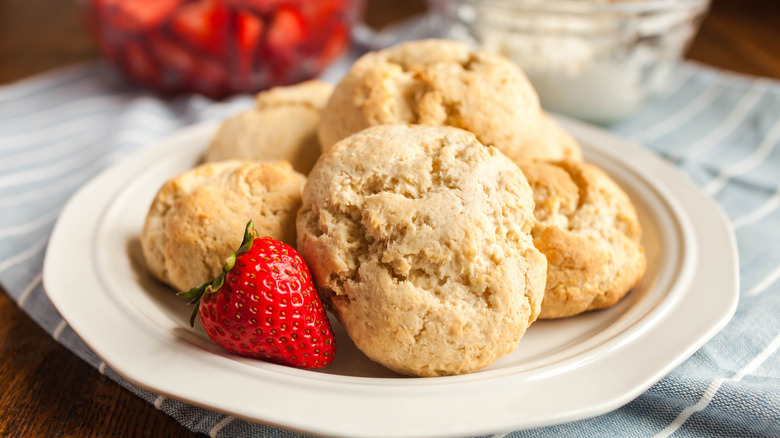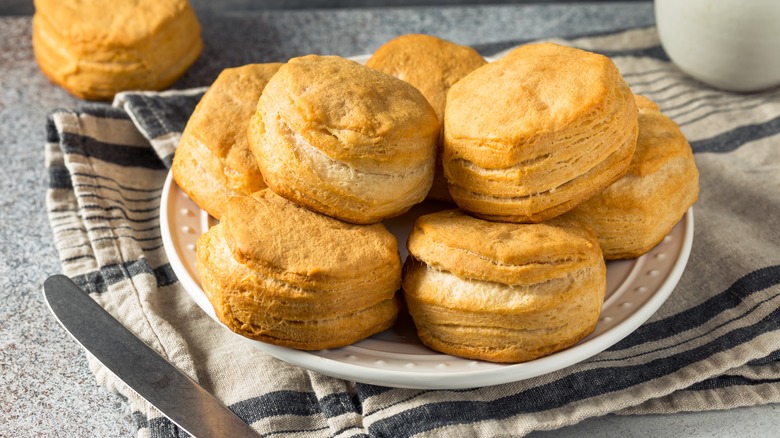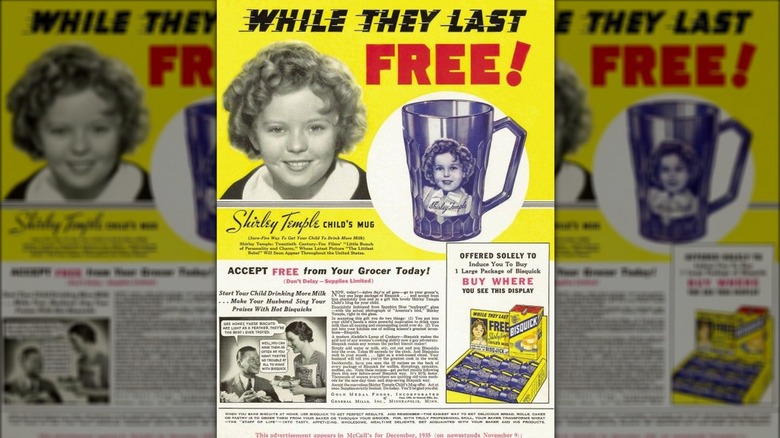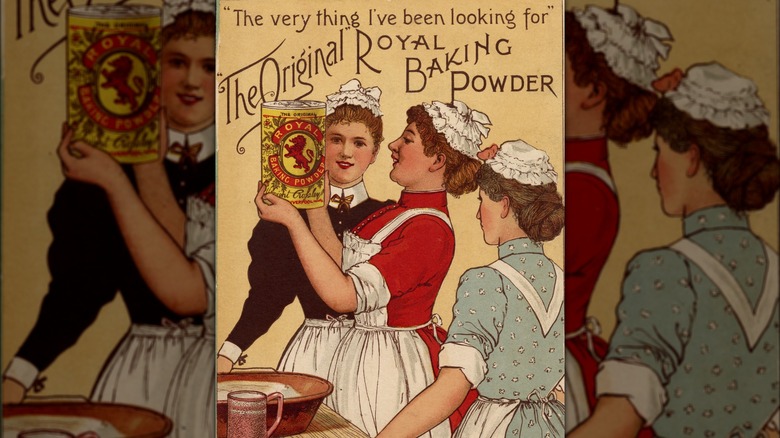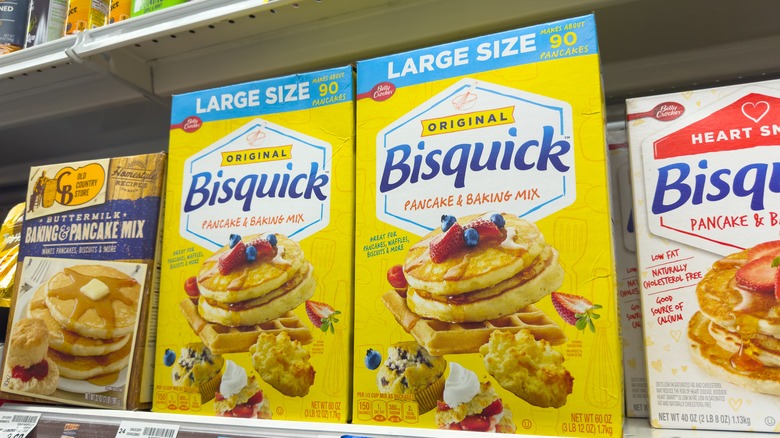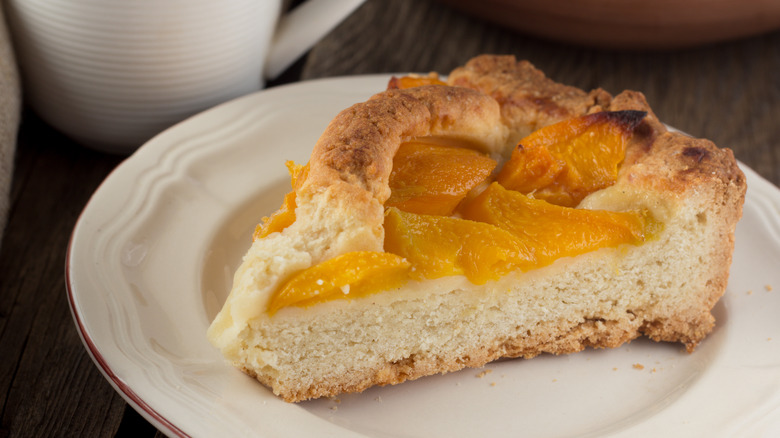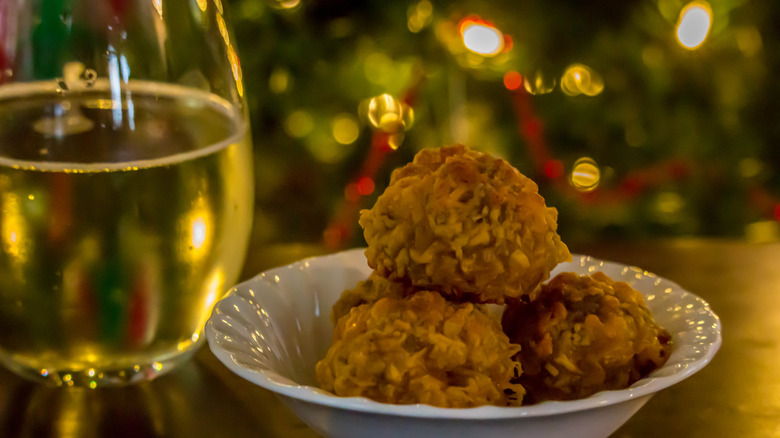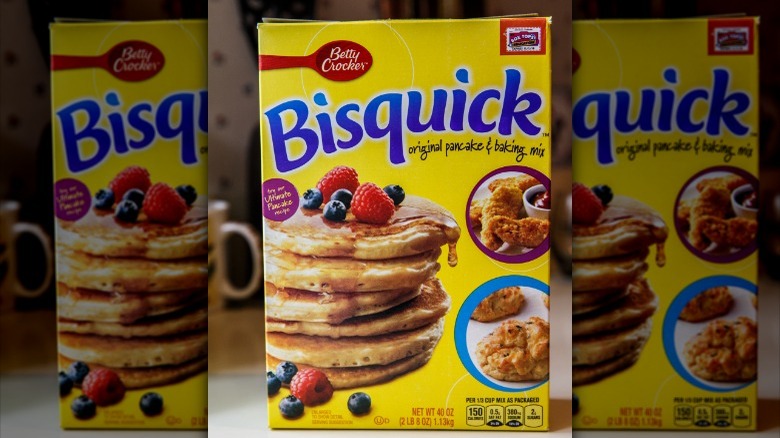10 Things You Might Not Know About Bisquick
The history of Bisquick mix goes back about a century, and it's one full of twists, turns, and unbelievable stories, as well as plenty of mundane facts and corporate mandates. For the sake of keeping readers awake, though, let's focus on the most interesting points in the history of this iconic General Mills box mix.
Fans of the brand know that Bisquick is an all-purpose quick mix that can make more than just biscuits. For decades, it's been used to make pancakes, waffles, shortcakes, and any other kind of baked goods you can think of. But there is more to its story than meets the eye. All the way back to the discovery of the formula that makes this magic mix work, Bisquick has had more going on than the average consumer might give it credit for. Even if you have a box of the stuff in your pantry, you may not know these interesting facts about Bisquick.
1. The original recipe for Bisquick was stolen from a Black chef
The story goes that in 1930, a salesman by the name of Carl Smith was on a train headed toward San Francisco, and the dining car had closed. A bit peckish, he asked the train's chef if there was anything he could whip up quickly that wouldn't be too much of a burden. When the chef returned with a plate of homemade biscuits, Smith was amazed and inquired into how exactly that feat of baking was done on a train, and so quickly too. And so it goes that the chef revealed his secret to the salesman for free. The formula of lard, baking powder, flour, and salt was passed along to General Mills' food scientists, some tweaks were made, and within a year, Bisquick was born.
If something doesn't quite sit right to you about that whole story, you're not alone, and it's more than just recipe theft. Even though it was first mentioned way back in 1954, in James Gray's book "Business Without Boundary: The Story of General Mills," it still hasn't become common knowledge that the chef in question was a Black man. The Black chef who invented the formula that would eventually become Bisquick was never credited, and to this day his name is unmentioned and unremembered.
2. Bisquick's 1931 debut started a biscuit revolution
The word "biscuit" has existed longer than the United States has, as any English readers will be well aware of. Still, it wasn't until the 1930s that the American biscuit, the fluffy and buttery kind, was popularized outside of the southern U.S., and the launch of Bisquick in 1931 was one of the two major events that year that started a biscuit revolution.
In the first year that Bisquick was on the store shelves, it was a hit product that resulted in a rapid influx of competitors emerging quickly to the scene. The appearance of Bisquick suddenly made baking biscuits a cinch, and not so much of an hours-long chore, so naturally others would want to hop aboard the bandwagon. Today, few of those brands have survived.
Another important thing happened in 1931. An inventor named Lively Willoughby got a patent approved for the manufacture of refrigerated biscuit dough. Served in a tube, these oven-ready biscuits were an even easier alternative for those who didn't want to spend hours making biscuit dough. These were first sold by Ballard and Ballard, a company that was eventually acquired by Pillsbury in 1951.
3. Bisquick ran ads with Shirley Temple in 1935
Even by the middle of the 1930s, the Bisquick marketing push was in full swing. It would evolve over the years, eventually landing on the slogan "A World of Baking in a Box" in the '40s. But in 1935, Bisquick crossed over with the biggest child star of the era, Shirley Temple, namesake of the popular mocktail.
General Mills partnered with Temple in the 1930s to advertise its products. Most prominently this included the now-famed Wheaties boxes which she graced the cover of many a time in her most iconic outfits. However, Temple also appeared in a print advertisement for Bisquick, encouraging fellow kids to drink their milk. How do those two messages (drink milk and buy Bisquick) go together?
Well, for one, the two items do indeed go together, as milk is one of the ingredients you need on hand to add to dry Bisquick mix to make biscuits. The other is that the ad was also promoting a limited-edition child-sized mug with Temple's face on it. Back then, making sure children drank their milk was a much bigger deal. To secure this prized item for your child, all you needed to do was buy one large package of Bisquick, while supplies lasted, of course.
4. Bisquick's success was a side effect of baking powder companies' cutthroat marketing
Baking powder was first invented by food scientist Alfred Bird in 1843, although he wouldn't live to see his invention become a pantry staple. It would take nearly 100 years for baking powder to become commonplace. During the first few decades of the 20th century, various baking powder brands fought a cutthroat battle in terms of marketing and pricing. Royal Baking Powder infamously ran advertisements discrediting competitors like Clabber Girl and Calumet and spread misinformation about the health hazards of their products.
The Great Depression only worsened things. At this point, baking powder also hadn't yet begun appearing as a standard ingredient in cookbooks, the way it has been for many decades now. As a result, 1930s home cooks celebrated Bisquick's ease of use, an attribute that the product has marketed itself on ever since. The lack of reliable information around baking powder was one of the reasons Bisquick quickly became trusted as a brand.
5. The original formula was first changed in the 1960s
For over 30 years, that formula brought to market in 1931 was good enough for General Mills, but in 1965, a change was called for, and the formula was adjusted in order to produce improved biscuits. This change in the '60s was just the tip of the iceberg. The brand would go on to grow in the years that followed, introducing further formula changes as well as releasing new products into the market to widen the appeal of the Bisquick name.
Now sold by General Mills subsidiary Betty Crocker, Bisquick Original remains a staple in grocery stores. As of 2023, the ingredient list includes bleached wheat flour, partially hydrogenated vegetable oil, leavening agents, dextrose, and salt. In the nearly 100-year history of the brand, there have been numerous new items spun off from Bisquick with different ingredients. These include Bisquick Gluten Free, Bisquick Heart Smart, and Bisquick Shake 'n Pour.
6. Bisquick was used to make the world's largest peach shortcake
Once upon a time, some motivated bakers in South Carolina took it upon themselves to make the largest peach shortcake imaginable. It actually wasn't that long ago. In 1981, this behemoth cake was created to break records at the South Carolina Peach Festival. Dubbed the World's Largest Peach Shortcake, this giant dessert measured 25 ½ feet in diameter. How exactly did they pull it off? With Bisquick, of course.
While we can't confirm if this is the largest Bisquick creation ever made, it certainly ranks among them. This shortcake gained the title by using more than 4 tons of Bisquick and 9 tons of peaches.
At the time, festival chairman Wayne Humphrey had a knack for trying new, ambitious peach creations every year. Before 1981's Peach Festival, Humphrey had presided over the World's Largest Peach Pie in 1978, as well as the World's Largest Peach Milkshake the subsequent year in 1979.
7. Bisquick had a fan club and newsletter in the 1980s
By the 1980s, Bisquick was a household name, and it even had a fan club. Well, sort of. People across the country could sign up for the Bisquick Recipe Club. All they had to do was send in the mail-in certificate along with $3.75 and they were all set. In turn they would receive the Bisquick Recipe Book Binder, a large yellow binder that came with a long list of recipes one could easily make using Bisquick combined with other pantry and grocery items. It also gave Bisquick fans a very convenient place to store their copies of the Bisquick Banner, the newsletter that members of the Recipe Club received by mail.
The Bisquick Banner was a recipe-focused newsletter that went out every two months or so. Each issue was a small, four-page spread, hole-punched so that it could go right into the recipe club binder. Each Banner was themed and provided recipes, advice on how to cook, gift ideas, and various food facts. Before blogs, there was Bisquick.
8. Bisquick played a role in the LAPD's Rampart scandal
In the late 1990s, a series of scandals across the Los Angeles Police Department's Rampart division led to the disbanding of its anti-gang team, CRASH (Community Resources Against Street Hoodlums) in the year 2000. A series of crimes committed by corrupt LAPD officers within this unit led to an investigation performed by an internal task force created in 1998 to root out the corruption. One of the major crimes discovered was the theft of $1 million worth of cocaine from evidence by CRASH officer Rafael Perez, who then sold the drugs.
The funniest part of the story, and the part most relevant to this topic, is that to conceal his theft, Perez replaced the cocaine with bags of Bisquick. After the detectives looking into the case were altered to some suspicious paperwork, LAPD chemists discovered Perez was switching out the valuable drugs with this everyday box pancake mix. This discovery allowed them to link Perez to 8 pounds of missing cocaine.
9. Bisquick isn't used just for baking
As we've established, there is a whole pantry's worth of ingredients in Bisquick mix, including cooking oil. Since Bisquick is made up of many of the basics you'll find used in kitchens, there are lots of ways you can incorporate the mix into your cooking.
There are tons of weeknight dinner and dessert recipes you can make using Bisquick that you may not have heard about. A classic meal that we associate with childhood is chicken with Bisquick dumplings on top. That was an easy shortcut for Mom. You can also use Bisquick to bread chicken fingers or other traditionally dredged and fried dishes like chicken fried steak.
One savory dish has a history with Bisquick that goes way back: Bisquick sausage balls are a simple party appetizer, consisting of only three ingredients — ground sausage, cheddar cheese, and Bisquick mix — and they've been around since at least the 1960s.
10. Bisquick mix is more expensive than making your own pancakes
In the modern era, pancakes have become one of the go-to reasons people use Bisquick. Bisquick pancakes are easy to make and cheap, so what could go wrong? Well, about that second part, we might have some news for you.
In 2012, HuffPost crunched the numbers and deduced that while it may be easier than making pancakes from scratch, it is not cheaper. Making pancakes with Bisquick was slightly more expensive at the time, compared to getting the ingredients on your own. We've come to the same conclusion with current pricing information.
It was certainly more expensive to make pancakes in 2023 than any year before, as we saw a huge uptick in prices of eggs, especially earlier in the year. While the average cost of flour per pound has only increased by an average of a few cents since 2012, the price of Bisquick has increased substantially. HuffPost paid $3.59 for a 40-ounce box of Bisquick mix in 2012. The cheapest place we could find the equivalent for sale online was at a local Smith's, where it's sold for $5.79.
Due to droughts in 2024, flour prices were on the rise, so it's worth watching the price of Bisquick increases.
